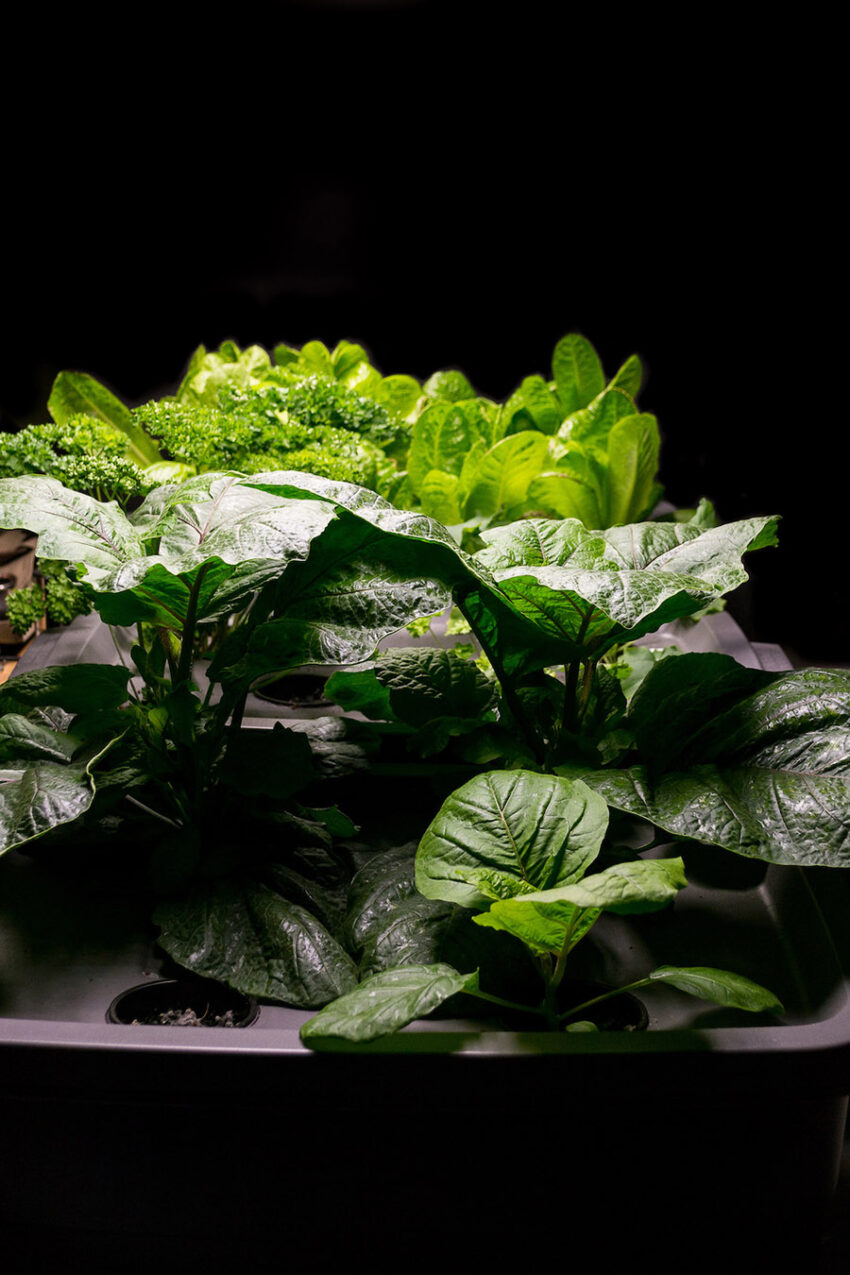by Bluestem
 OFF-GRID HYDROPONICS: The Kratky Method
OFF-GRID HYDROPONICS: The Kratky Method
It’s been many years since our two-car garage held any vehicles. After installing sliding glass doors in the openings, the space now serves as sunroom, office, studio, dogs’ quarters, gym, and pantry. And as of early November, it’s also where we grow some of our food. In water.
I was familiar with the concept of hydroponics, of course, but had thought of it as complicated, cumbersome, and high-maintenance. (The marijuana grow houses sprouting up all over Oklahoma also come to mind.) But a couple of months ago, I learned about a simple system one can assemble using easy-to-find materials that doesn’t require electricity or moving parts. At the time, I didn’t seriously consider trying it, but the idea wouldn’t go away. Fast forward to today, and I’ve got water-filled storage bins growing eggplant, parsley, basil, cilantro, kale and more lettuce than my husband and I can eat.
In a nutshell, the process goes like this: fill bins or buckets with water, stirring in enough nutrient mix to reach desired level, based on plant type and stage of growth. Check the pH with strips or a meter and adjust up or down to reach optimum level, again based on plant type and stage of growth. Place the lids on the bins and fill net pots with coconut coir. Place pots in holes. Put seeds in each pot. Turn on the lights. Patiently wait and watch as the miracle of plant life unfolds.

About all that is required after that is adjusting the nutrient and pH levels and checking the level of the water. I’ve found it helpful to keep a journal on the progress of each bin, noting the nutrient (Total Dissolved Solids/TDS) and pH numbers; when I’ve added nutrients and how much, etc. I check the level of the water in the bins about once per week. The grow lights stay on for 12 hours each day. Plants need a dark rest period, just as we do.
My gardening skills lie somewhere between a green thumb and a black one and I have the attention span of a fruit fly, making hydroponic gardening ideal for my temperament. Thankfully, I’ve found that plants are very forgiving. Currently we have three, 10-gallon bins producing food and have room for one more. I may fill it with medicinal plants and herbs – a kind of natural medicine cabinet.
To get started look up the Kratky Method (named after B.A. Kratky, the University of Hawaii horticulturist who came up with the idea) via search engine. You’ll find everything you need to know – and much more – to start and maintain a system. For my low-tech brain, I’ve kept the process as simple as possible. As long as the plants are growing, I’m happy.
The initial shopping list looks daunting, but the components are easy to find and affordable.
You’ll need:
- Water
- Heavy duty 10-gallon plastic bins (such as Rubbermaid Roughneck plus the lids*), or 5-gallon buckets with lids
- Net pots
- Growing medium (such as coconut coir)
- Grow lights (I use Spider Farmer brand) or an indoor spot that gets a full day of sunshine
- Nutrients (I use Masterblend)
- Seeds, such as salad greens, cooking greens, tomatoes, and herbs
- pH control kit
- pH strips or a pH meter
- Total Dissolved Solids (TDS) meter
- A few minutes per week, once the system is up and running
Even if you only have room for, or all you can afford is one or two bins, the amount of greens produced could easily feed two people for weeks. With supply chains collapsing, toxic pesticides coating our fruits and vegetables, GMO everything, farmland being bought up by a certain creepy billionaire, and the recent news that scientists are creating Frankengreens that deliver mRNA vaccines – growing one’s own food is becoming an imperative.
The benefits of growing hydroponically:
- no weeding or need for herbicides
- no pests, hence no nasty pesticides
- no watering
- no digging
- work at waist-level;
- year-round growing season
- fresh, organic food with zero influence from creepy billionaires
I get a thrill each morning when I turn on the grow lights and check the plants. It never ceases to seem like a miracle that beautiful, healthy, nutrient-giving plants are growing in nothing but fortified water. I have to admit that harvesting the greens breaks my heart just a little bit. Yet, I carry on through my tears.
*Holes need to be drilled into the lids in which to suspend the net grow pots. My husband used a drill with a circular hole saw to make 2-inch and 3-inch holes. The number of holes per lid and hole size are dependent on what you are planning on growing. I purchased my bins on eBay as the price was better at the time than on Amazon. You could also use 5-gallon buckets, one plant per bucket, and I’ve seen Mason jars used as well.

MICROGREENS: Even less maintenance
If a non-circulating hydroponic system is more than you want to tackle, have space for, or can afford, consider growing nutrient-dense microgreens such as broccoli, radish, arugula, and kale. All you need is a tray, some seeds, and hemp mats or other grow medium (coconut coir works here, too). I purchased a 10-inch kit and a 20-inch kit (Skyhaven brand), both of which come with everything needed to get started. It’s amazing how quickly the seeds sprout. Fresh microgreens are far superior to what one can get at the grocery store and you only harvest what you need when you need it.
